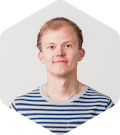Two-sided marketplace strategy
Two-sided marketplaces have tremendous benefits. And unique challenges. This strategy guide helps you understand two-sided markets and build a successful marketplace business.
Two-sided marketplaces are phenomenal businesses. I've seen this first-hand as I've helped founders build successful marketplaces for over a decade with my company, Sharetribe.
But don't take it from me. Take it from the statistics.
In 2021, two-sided marketplace sales took 67% of all global eCommerce. By 2027, it's expected that third-party sales through online marketplaces will be the largest and fastest-growing retail channel worldwide.
Two-sided marketplaces can make buying and selling (or renting) anything extremely efficient. At the same time, the model comes with challenges. The founders who succeed are the ones who are prepared for the obstacles – and know how to harness the benefits to the fullest.
In this article, I'll share what I've learned over the 10+ years I've worked with marketplaces to help you make your business idea a reality.
This guide has also been turned into a video by Sharetribe's Head of Content, Mira.
A two-sided marketplace is a platform that brings buyers and sellers together. The platform helps these two groups find each other, interact, and make secure payments.
Famous examples are Airbnb, Uber, and Etsy, but there are thousands of smaller players out there that use this model very successfully. (More on that later!)
Marketplaces can operate in products, services, or rentals and for C2C (peer-to-peer), B2C (business-to-consumer), or B2B (business-to-business) audiences.
The most common way marketplaces monetize is through commissions. The platform takes a cut out of each transaction. A key benefit is that the marketplace only charges a fee when it provides value to its users.
(There are other ways to monetize – find out more in our guide to marketplace business models.)
Here's a graph of how the two-sided model works in practice:
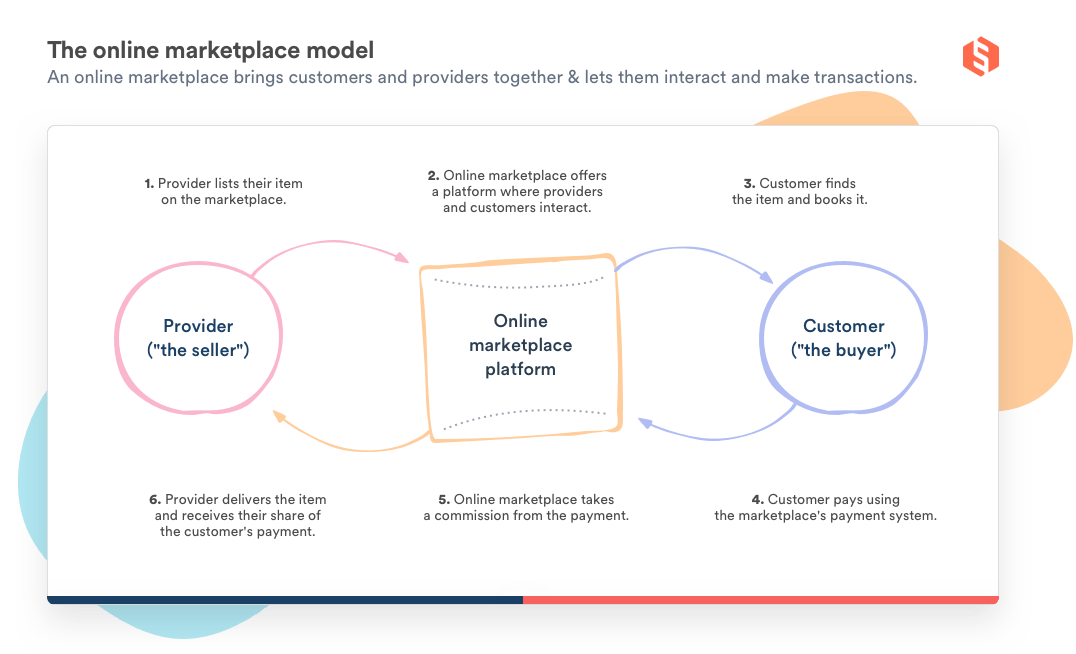
As you can probably tell from the list of examples, this model powers several unicorn companies. The trend shows no sign of slowing down: the PwC estimates that global revenues in the sharing economy can reach $335 billion by 2025.
But you don't need to take on the giants to build a successful two-sided marketplace.
Quite the opposite. The best way to start a marketplace (even one that eventually becomes a unicorn) is to succeed first in a small niche.
Marketplaces thrive across industries. Here are some examples of famous marketplaces and industries.
- Product selling: Amazon, eBay, Alibaba, Etsy
- Vacation rentals: Airbnb, Vrbo
- Transportation: Turo, Getaround, Gett
- On-demand services: Uber, Lyft, Doordash
- Groceries: Instacart, Mercato, Grubmarket
- Events: Eventbrite, SeatGeek, StubHub
- Freelance marketplaces: Upwork, Fiverr, Toptal
- Health & Wellness: Styleseat, Fresha, Booksy
- Fashion: Poshmark, Vinted, Depop
- Home services: Thumbtack, TasksRabbit, Handy, Dolly
- Education: Udemy, Coursera, MasterClass
- Childcare: UrbanSitter, KidPass, Wonderschool
These platforms all have their unique focus, but their core model is the same. They facilitate transactions between their user groups and make money in the process.
At Sharetribe, we're proud to power over 1,000 marketplaces, from small businesses to companies that have raised millions in funding. Here are three examples I wanted to highlight to showcase how solo founders and small teams can succeed with the two-sided marketplace model.
Drive lah is a peer-to-peer marketplace for car-sharing.
The idea for Drive lah was born out of frustration with the existing alternatives to renting a car in Europe and Asia. Renting from one of the established players was expensive, availability was spotty, and the cars always had to be picked up and dropped off at inconvenient locations.
When founders Gaurav Singhal and Dirk-Jan der Horst started Drive lah, their goal was to get the product out as quickly as possible. The decision paid off.
“The best thing we did was getting Drive lah to market quickly. We spoke to our users all the time, ran experiments, made tweaks to the platform, and continued to improve,” Gaurav says.
Today, the Singapore-based marketplace for car-sharing has expanded to Australia, grown to a business with a team of 30+ employees, and raised millions in funding from investors.
You can read the full Drive lah story here, and here's a podcast episode where Gaurav Singhal talks about balancing speed with quality.
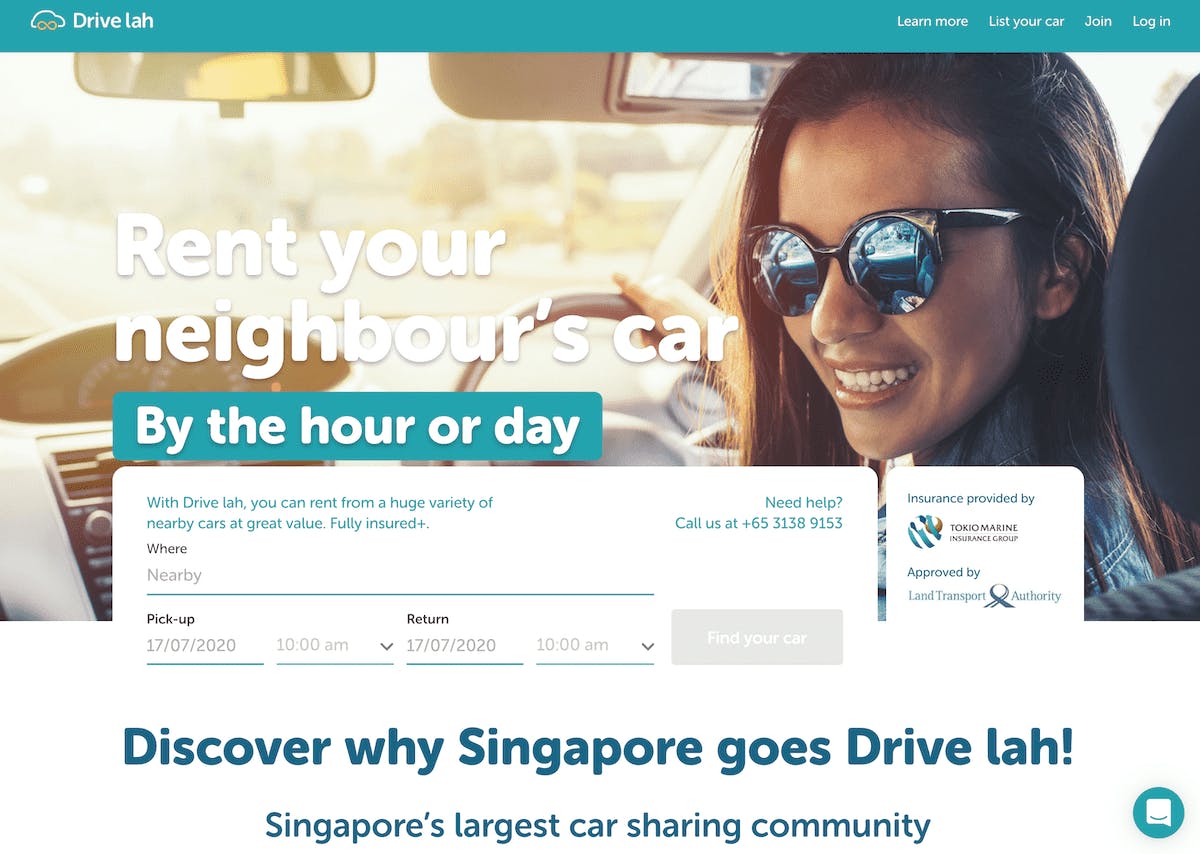
The Octopus Club lets parents buy and sell preloved clothes, toys, and other kid gear.
The founder, Ana Rachel Estrougo has bought her furniture and clothes second-hand for many years. But when she became a mother, she found it hard to buy quality items for her baby the same way. So she founded a marketplace to solve the problem herself.
For that first year, The Octopus Club was a one-woman show. Marketing, customer care, social media, taking product pictures, seeding supply – Ana did it all herself.
It was a crazy year, but looking back, Ana reflects on the moment she knew The Octopus Club could be a success: “When people I didn’t know started buying and selling from each other, it was a very powerful experience. That’s when I realized I had a business.”
However, for The Octopus Club to grow, Ana knew she needed help. She launched a crowdfunding campaign and in 15 days, she reached her maximum target of £150,000 pre-revenue. She's also been able to grow the marketplace organically, doing very little paid marketing.
Read Ana and The Octopus Club's entire story here.

Sugarlift is a mission-driven art gallery with a two-sided marketplace. The platform is bridging the gap between brick-and-mortar galleries and the digital world and wants to make buying art more accessible.
“The problem with the art market wasn’t a lack of artists or a lack of demand – it was a lack of infrastructure. I saw it as an economics problem. If we could remove the opaqueness of pricing and inventory and create engagement, we could help everyone discover great art,” says founder Wright Harvey.
Wright didn't have the technical know-how to build a marketplace website, but that didn't stop him from launching and growing Sugarlift. Today, there are over 500 artists on Sugarlift’s online marketplace, ten to twenty of whom are exhibited in the physical gallery every year.
Learn more about Wright and Sugarlift here.
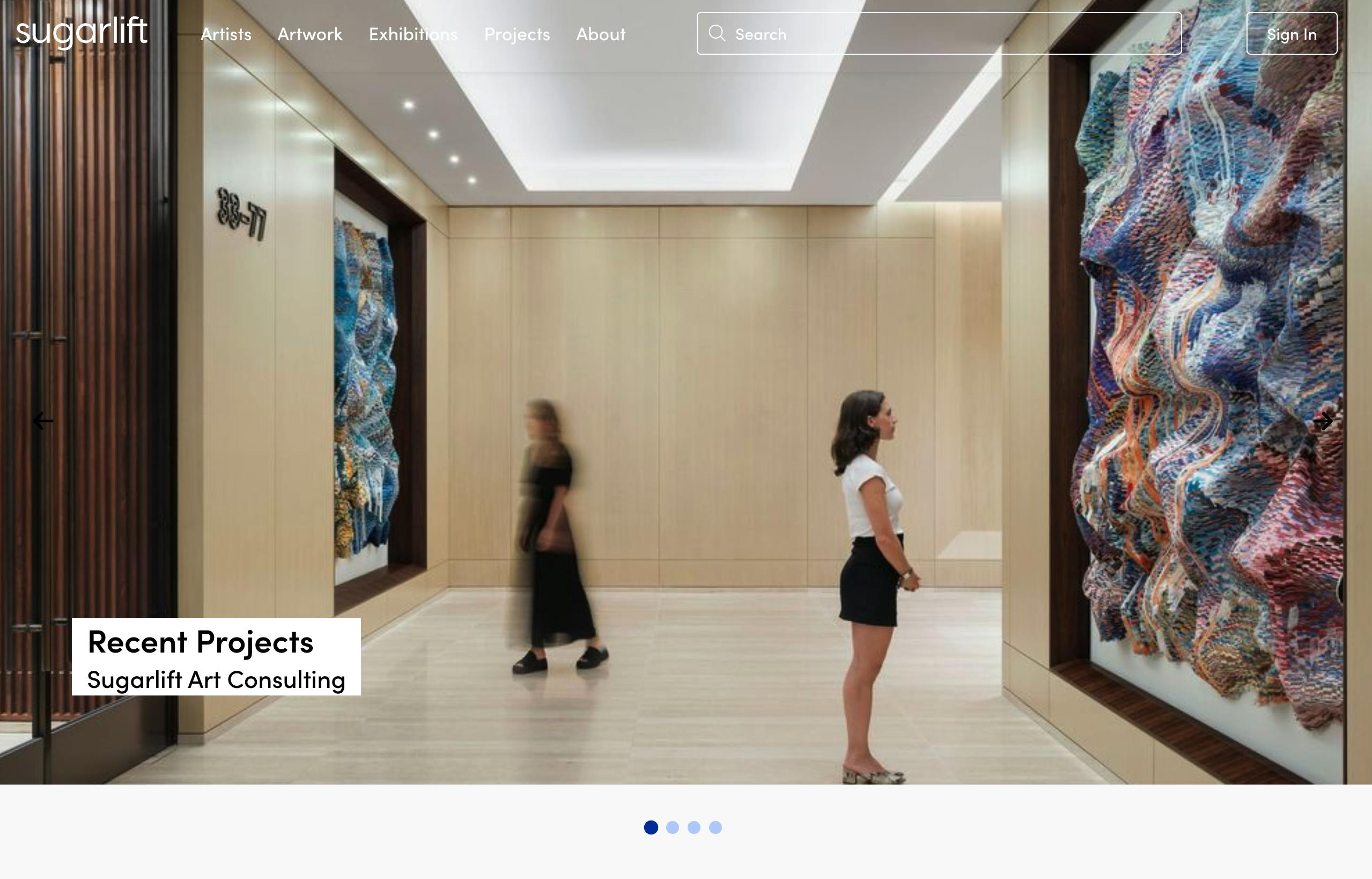
Marketplaces thrive when (and only when) they solve a problem for buyers and sellers.
For buyers, marketplaces
- make it easy to find and buy what they need
- give access to a wide selection to compare and choose from
- help find more affordable alternatives.
For sellers, marketplaces offer
- access to a big pool of customers
- a community to learn from and connect with
- a set of powerful tools to manage bookings and payments.
Importantly, the model offers significant benefits to the marketplace founder as well.
- Low initial costs and risk thanks to the two-sided model and great SaaS offering.
- The marketplace model can scale extremely well.
- Two-sided dynamics are a unique growth lever.
Let's look at each of the founder benefits in more detail.
If you want to start a conventional online store, you need to own or create the inventory you're selling. That's a big investment.
And a big risk if your business doesn't work out.
On a marketplace, your supply creates your inventory. You only need to invest in the platform where your supply can list their products (or services or rentals) and find customers.
Building such a platform used to require a big initial investment as well, but that has changed.
Coding the platform with all the two-sided functionality would take months and at least $50,000. Using no-code marketplace software like Sharetribe (or one of the many Sharetribe alternatives that are available nowadays) can cut the time and cost by as much as 90%.
This means if you have the beginnings of a marketplace idea, you could launch your business in a day. Without any initial investment other than your time.
Few other business concepts have equally low startup costs.
When you don't need to own inventory, it's not only getting started that becomes easier. Scaling is faster too.
You can introduce new categories or new locations with the same playbook you used to launch. Big, risky investments in physical infrastructure aren't needed.
If you've chosen your marketplace software well, you can easily adapt it as you grow. You can learn from real users and eliminate all the guesswork.
And only invest in building features and functionality you know can bring value to your user base.
In fact, there are many examples of successful marketplaces that have been built by bootstrapping. They haven't needed any outside investment to grow.
(That's not to say investments wouldn't be available – many investors say they are particularly drawn to marketplaces thanks to the unique growth possibilities.)
The most successful two-sided marketplaces grow through network effects and cross-side virality.
Network effects happen because the marketplace becomes more valuable to each user when the total number of users grows. More customers means more opportunities for sellers. More sellers means more selection and lower prices for customers. A virtuous cycle is born that conventional businesses could never achieve: the growth of a marketplace generates more growth.
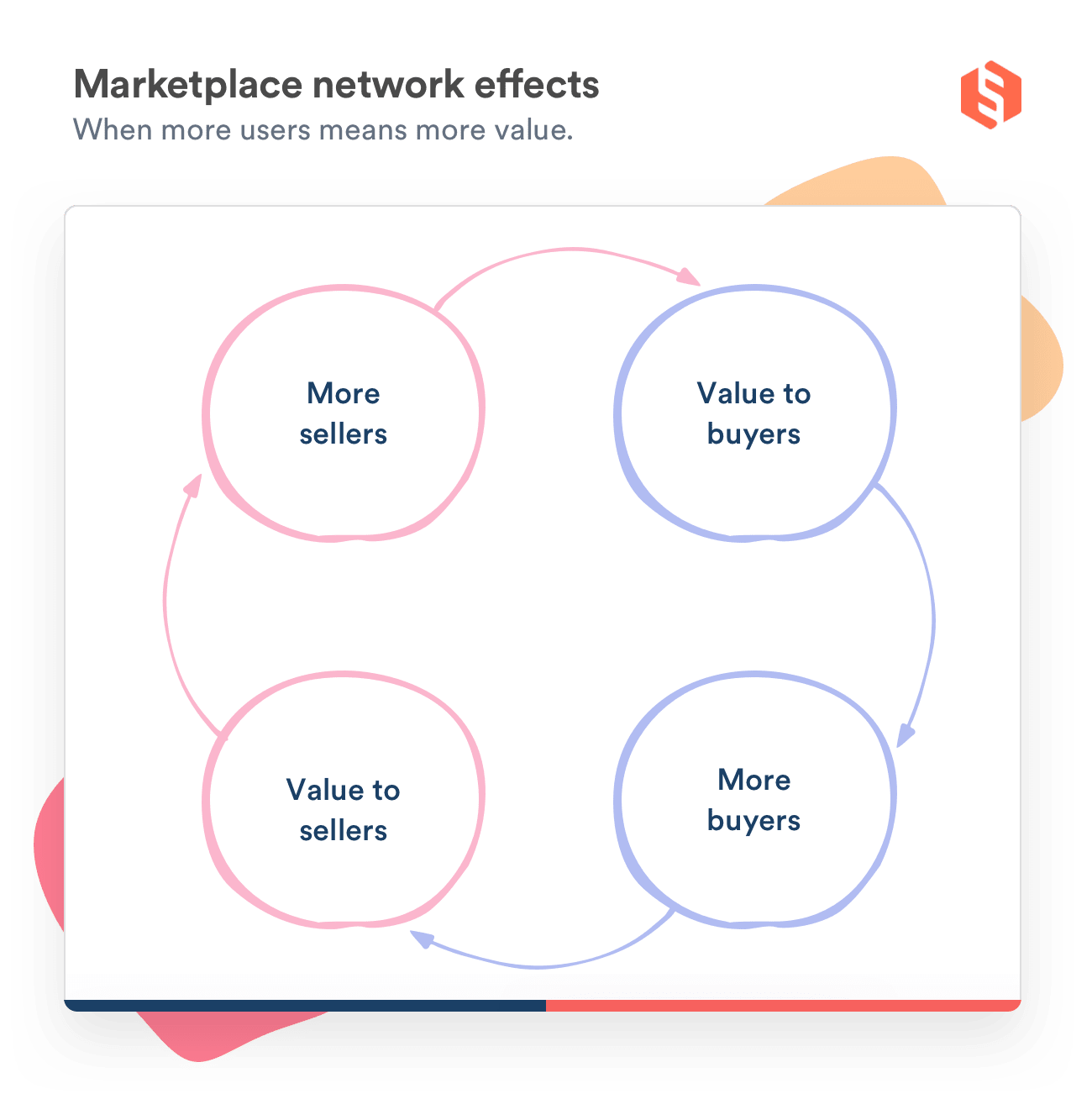
Cross-side virality is a tremendous benefit for peer-to-peer marketplaces – think Airbnb, Eventbrite, Etsy, or Poshmark.
(Former Eventbrite VP of Growth, Brian Rothenberg, said: "If cross-side virality is happening on your marketplace, be very happy. This is a huge lever.")
On any of these platforms, a new buyer is also a potential seller. So, whenever you acquire new customers, some of them will likely sign up and list their own items as sellers.
(It's no wonder all the examples I mentioned actively advertise the opportunity to become a seller to their new customers.)
Cross-side virality boosts the network effects of your marketplace. At the cost of acquiring a new customer, the platform also gains a provider, who brings in new customers who, in turn, become providers. And the wheel keeps turning.
The combination of these three benefits is powerful. But the coin has a flip-side.
Next, I'll introduce five stubborn challenges I've seen countless marketplace founders struggle with – and how they have managed to solve them.
What makes two-sided businesses powerful is also what makes them challenging.
If you're considering the model, take note of how successful founders have solved these five persistent marketplace challenges:
- Knowing what kind of platform you need to build
- Solving the chicken-and-egg problem
- Reaching liquidity
- Preventing platform leakage
- Defending against competitors
People love marketplaces. So if you go and for feedback on your marketplace idea, many will say they love it.
That doesn't mean they'll use it (or pay you for it).
But if you don't ask for feedback, you risk building a desert platform.
Cristóbal Garcia learned this the hard way. He first worked on a music quiz platform which the team developed for four years. The project failed – users didn't bite. For his next project, he spent thousands of hours learning to code a platform and two years building it. Then he learned his product didn't really solve a problem for users.
Cristóbal's mistake was that he didn't validate his marketplace idea first. But how do you do that if anyone you ask will say they love your idea without giving it a second thought?
By asking the users about them, not about your business idea.
1. List your assumptions. Break down your business idea by answering these questions:
- What problem are you trying to solve?
- Who has the problem?
- How is this person dealing with the problem now?
- How are you planning to solve the problem?
- Why is your solution better?
You could also already list your assumptions about your value proposition and user acquisition channels.
2. Interview potential users to validate your assumptions.
Ask them open-ended questions about how they currently solve the problem you're tackling. Try to understand their experience and their pain points.
Take the opportunity also to ask how they find information – this will help you plan your growth strategies.
After going through this process, you should have a relatively good idea of your users' problem – and how it could be solved. As marketplace investor Mathias Ockenfels told us: "If your marketplace doesn't solve a real problem, it doesn't have a reason to exist."
Here's Cristóbal's thorough article on how to validate your marketplace idea.
Marketplaces with the best supply win customers. Marketplaces with lots of customers attract the best supply.
What can you do when you need one side to get the other?
This is called the chicken-or-egg problem, and there are many tactics to combat it. In my experience, the best tactics focus on getting the harder side to commit to the platform first. That's usually the supply.
Here are some ideas for building the initial supply for a marketplace.
Contact suppliers who are active on other marketplaces. You'll need to have something better to offer them. Think: better tools, smoother payments, more trustworthy environment.
Go to online forums or Facebook groups. There may even be some online business directories for your suppliers.
Knock on doors and cold call. Sounds old-fashioned, but I've seen this work countless times. Greenpal founder Bryan Clayton and his co-founder handed out over 100,00 door hangers. Florence co-founder Charles Adler drove nurses to their shifts. Nomady co-founders Oliver Huber and Paolo De Caro went door-to-door building relationships with landowners.
Build a single-player mode. Bring supply in with a value proposition that doesn't require customers. Like great tools to manage bookings and handle payments and taxes. This tactic worked really well for Freightos.
On the topic of chicken and egg problem, I recommend NFX's 19 Tactics to Solve the Chicken-or-Egg Problem and Grow Your Marketplace. It's a classic.
Two-sided businesses need to find a balance where both sides – sellers and customers – are just the right size to serve one another.
This is called liquidity. Liquidity means the likelihood of a seller making a sale on your marketplace and of a buyer finding what they're looking for.
And if you ask any marketplace expert, investor, or founder, it's the north star metric for any marketplace.
If you take away one thing from this article, I hope it's this: Don't focus on volume when you start a marketplace. Focus on liquidity.
Build something that solves a painful problem for a small number of users. Focus on a tight niche (like music studios) and/or a location (Singapore – but you could go as small as a single city or neighborhood) and find liquidity. Build a small user base that loves your product.
After you have found liquidity, you can start growing your marketplace. And you now have a playbook you can use to expand, one successful location at a time.
Marketplace leakage is a risk you get as a by-product of the two-sided model.
Leakage happens when sellers and buyers use your marketplace to find each other, but make the payment outside of your platform. And skip paying your commission.
There are a few technical things you could do to remedy leakage. Many marketplaces limit communication on their platform or only reveal the full name or address of users after a payment has been made.
These tactics can work or they can backfire if they hurt your user experience.
In my experience, the best way to deal with leakage is to prevent it. If users get enough value from your marketplace, they won't go through the trouble of bypassing your payment system just to avoid your commission. Smooth and secure marketplace payments are a vital component.
The value you provide can be:
- Security and trust. Reviews, verified users, insurance, reliable payments, buyer protection. Anything that gives people peace of mind about transacting with strangers.
- Tools. Help sellers manage their bookings or stock, handle cancelations or returns, and file their taxes. Well worth a small commission.
- Reduced friction. Buyers tend to value convenience even over the lowest prices.
A marketplace lets strangers interact and exchange money and goods. This can only work if there's trust.
Your users need to trust both each other and your marketplace. Creating trust should be a key strategic goal to consider throughout building your business. Here are some examples of ways to build marketplace trust:
Curate your supply. Focus on quality over quantity and help your sellers craft thorough, informative listings. They're an immediate trust signal.
Establish rules. Create a code of conduct and be strict and transparent about enforcing it.
Help users communicate with and relate to one another. A low-key communication tool on your marketplace can do wonders. As can user profiles with photos and some relatable personal information.
Build trust into your platform. User verification, double-sided reviews, secure payments, and escrow are examples of technical features that support trust.
Offer trust-enhancing additional services. Could you add insurance, or buyer protection into your offering?
Creating trust is a requirement for a marketplace to work. It's also the groundwork for building a defensible marketplace brand. Through building trust, you can start turning your marketplace user base into a community.
Copying your marketplace idea and platform technology is easy. Stealing away a community of committed users is hard.
Julia Wadehn, former COO of the RV rental marketplace PaulCamper, said of their community:
"Our community gives us a unique selling point, high defensibility, and great retention of supply. For many of our customers, being a part of the PaulCamper community has led to a deep emotional connection. They won’t list elsewhere because they want to be a part of PaulCamper’s story and help us become the biggest."
We've covered a lot of marketplace examples and success stories. Now, let's focus on you: how you can build your own marketplace platform and launch your business.
In my experience, the simplified steps to build a successful two-sided marketplace are:
- Decide on your tech stack (how you build the platform).
- Build your MVP (Minimum Viable Platform).
- Bring in your initial supply.
- Launch to customers.
- Build, learn, improve – repeat.
Building a marketplace startup is a big undertaking with lots of details to consider at every step. I'll focus here on giving you an overview and link to more in-depth resources you can check out when you need them.
1. Choose how you build your marketplace. There are many ways to create a two-sided marketplace website. Here are your options, with links to read more about each.
- Coding from scratch. Huge undertaking, takes lots of time and senior dev skills or a budget north of $50,000. Rarely recommended.
- Coding on top of open-source software. Can be slightly easier and cheaper. Not the best developer experience.
- Building with WordPress. Easier still, takes a month or two and some dev. Interplay of several independent plugins may mean issues with UX and maintenance.
- Using a combination of no-code tools requires no coding skills, but learning the no-code language can take surprisingly long.
- Using a no-code marketplace SaaS tool. By far the fastest and easiest option. Also the least customizable.
- Using an API-based marketplace tool combines the benefits of SaaS and custom development. Easy to launch, yet customizable and scalable.
For by far the most founders, the best solution is whatever gets your first version launched the fastest.
2. Build your MVP (Minimum Viable Platform). Build a version of your marketplace idea that solves a core problem for a core group of users. Nothing more, nothing less. Don't make it buggy or ugly, but also don't waste precious time building anything that isn't absolutely crucial for testing your idea. Launch as fast as you can and start learning about your audience.
Here's our guide on how to build a Minimum Viable Platform. It helps you combine minimum viable with a site that's also lovable from day one.
3. Bring in the initial supply. Seed your marketplace with high-quality supply before you launch it to customers.
Here's our guide on building marketplace supply. I also recommend Mike Williams' article on how he onboarded and grew the initial supply for his marketplace Studiotime.
4. Launch to customers. When you have a good number of initial listings on your platform, it's time to launch to customers. If you validated your idea well before building your MVP, you may already have ideas on where you can find the first set of customers.
Here's a guide on planning the product launch and marketing launch of your marketplace. And here's our most comprehensive article on selecting your marketplace growth strategies.
5. Build, learn, improve, repeat. At this stage, you have a good balance of supply and demand and you've reached (or are well on your way to reach) liquidity. Now you have real users you can monitor to make data-driven growth decisions. Analyze the user journey, interview both sides and identify the biggest bottlenecks. This way, you're spending dev resources on things that really drive growth.
Here's a guide on the key marketplace metrics to track.
Two-sided marketplaces connect buyers and sellers. Examples like Airbnb, Uber, and Etsy show how these platforms thrive across markets and niches.
Successful marketplaces benefit from low initial costs, scalability, and two-sided dynamics. These are tremendous benefits for a founder.
At the same time, marketplaces have unique challenges: solving liquidity, balancing supply and demand, building trust, and managing platform leakage.
Most importantly, founders need to balance building a technically advanced platform with moving quickly and iteratively.
For most founders, the key to success is prioritizing building their user base. They built a barebones Minimum Viable Platform and started facilitating transactions and learning about their audience. Onlt once they knew enough about their users' behaviour did they invest more into their tech.
This is the approach I warmly recommend for you, too. It's the best way to build something people will really love, without heavy upfront investment and risk.
If you're in the market for marketplace software, I hope you check out Sharetribe's extensible no-code marketplace builder. It'll get you a fully functional two-sided marketplace up an running in a matter of days.
And even if you're not, I hope this article and the resources I've shared help you in your journey. We intentionally write all our content to be helpful to any marketplace founders, regardless of how they build their platform.
I wish you the best of luck with your marketplace business!
If you're interested in some more resources on building, running, and scaling two-sided marketplaces, here are a few you could check out.
Two-sided – interviews with top marketplace experts and successful founders
Create a marketplace – the complete guide
Start your 14-day free trial
Create a marketplace today!
- Launch quickly, without coding
- Extend infinitely
- Scale to any size
No credit card required
